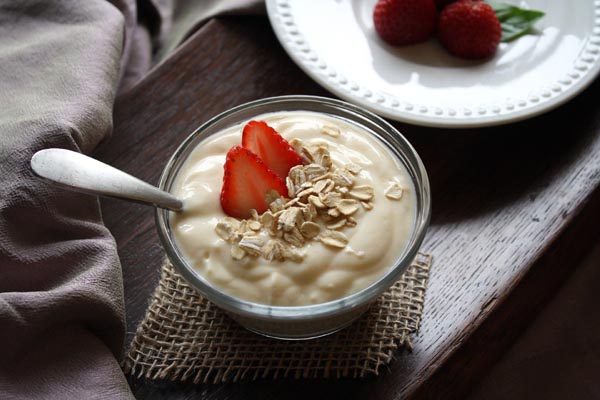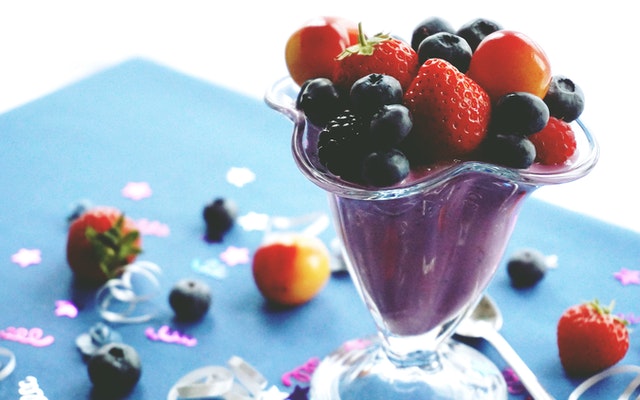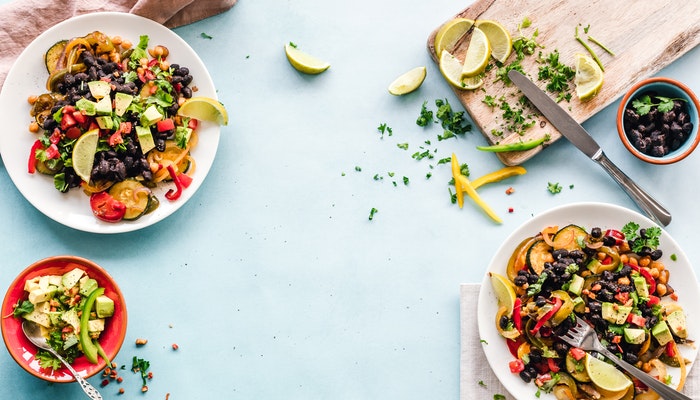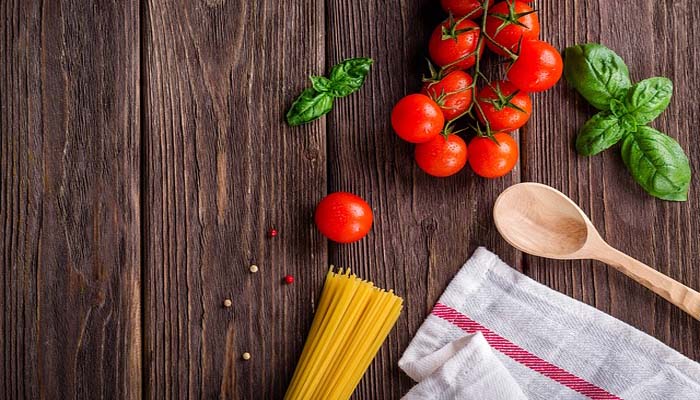
Sugar is released into our bloodstream to provide our muscles, brain and other organs with energy. The average adult’s body contains about 5 litres of blood. There should be around 4 grams of sugar in the blood at any given time – that is less than a single teaspoon of sugar.
When we eat foods that are high in simple sugars, added sugars or refined sugars; excess sugar gets dumped into our bloodstream. This leads to a spike in blood sugar. The body tries to balance out this sugar spike by shuttling it into storage. This leads to a severe drop in sugar levels rather quickly –which can lead to low blood sugar levels. Low blood sugar levels cause low energy and cravings for more sugar-dense food. After eating food that is high in sugar, the cycle starts all over again.
By eating foods that are low in sugar, or which release sugar into the bloodstream at a slower rate, we can avoid sudden spikes and drops in blood sugar.
Eat foods that are high in protein and fats in the morning
Your first meal of the day is the one that breaks your night-long fast (hence the name, breakfast). This meal will set the tone of the rest of your day. If you eat a meal that is high in sugar, your blood sugar will spike and drop quickly. This will put your body on a rollercoaster of sugar highs and sugar lows that drop your energy levels and leave you craving for more unhealthy food.
By eating a meal that is high in protein and fat, which takes longer to break down, your blood sugar rises steadily and drops more evenly. This will avoid sugar spikes and increase the length of time before you feel hungry again. This sets a positive effect that lasts throughout the day because your energy levels will be more evenly sustained and you will have fewer cravings for unhealthy food.
Choosing the best first meal of the day is very important because of increased blood sugar sensitivity after waking up. Your body is sensitive to the first meal that you eat because of the long period of time that your body has gone without consuming any nutrients.
Food groups that don’t spike your sugar levels
Refined carbohydrates (white flour, pastries), added sugar (pop/soda/ fizzy drinks, cereals with high sugar content), and simple sugars (table sugar) should be avoided if you don’t want any sugar spikes.
These are the food groups that you should be eating instead. These foods release sugar into the blood stream at a much slower rate.
1. Protein
Protein takes longer to break down than carbohydrates. More energy is needed to digest them. Between a fifth and a third of the caloric content of protein is used to break it down into useable nutrients.
Avoid protein sources that are covered in carbohydrates or are fried (like fried chicken, fish fingers or chicken strips). Fried foods are superheated in the frying process. This makes the food high in unhealthy oils that contribute to obesity, diabetes and heart disease. Processed meats like salami or sausages are also unhealthy sources of protein because a lot of sugar, sodium and preservatives are added to them.
2. Fat
Fat is more of a long-form type if energy than carbohydrates. This means that it takes longer to be turned into useable energy. Stick to healthy fats like avocadoes, eggs, fish, nuts, olive oil and cheese. Avoid unhealthy fats like industrial trans fats, partially hydrogenated oils and saturated fats that you would find in fried oils, processed meat and highly processed foods.
Generally, the less processed a food, the less unhealthy fats it contains. Aim for foods that are either single-ingredient or have a shorter ingredient list on the packaging.
3. Fibre
Most people who follow a western diet don’t eat enough fibre. Fibre is the part of plant food that your body cannot break down. The fact your body can not digest fibre is what makes it so healthy. Fibre adds bulk to your bowel movements and is commonly referred to as nature’s broom because it cleans out your gut. Healthy gut bacteria need fibre to thrive.
Since fibre is not digestible, foods that contain fibre take longer to break down and release sugar into the blood stream at a much slower rate. This is why fruit and vegetables don’t spike blood sugar in the same way as processed carbohydrates.
4. Low-GI Carbohydrates
Not all carbohydrates are created equal. Some carbohydrates will spike blood sugar by dumping too much sugar into the blood stream very quickly, while others won’t.
We use the Glycaemic Index (GI) to rank carbohydrates according to how they impact blood sugar levels. Carbohydrates that have a lower GI score are healthier because they release sugar at a slower rate. Fruit and vegetables are naturally low GI.
Low GI carbohydrates include whole-wheat flour, pumpernickel bread, oats, muesli (without added sugar), pasta, barley, sweet potato, corn, legumes, yams and most fruit and vegetables.
Foods that help to balance blood sugar
Now that we’ve covered how different macro-nutrients and food groups can affect blood-glucose levels, we can investigate how individual foods can improve blood sugar levels.
1. Fatty fish (salmon, anchovies, mackerel, herring and sardines)
Besides being a great source of protein, fatty fish contains Omega 3. Omega 3 is an essential fatty acid that most of us don’t get enough of. The ideal diet should contain a balance of Omega 3, 6 and 9. We often have too much Omega 6 and 9, which we get from plant oils, and not enough Omega 3, which comes from fatty fish, nuts and seeds.
Omega 3 supports proper heart health, cardiovascular function, brain performance, eye health and hormonal balances. Getting enough Omega 3 is very important for people who struggle with blood sugar (especially diabetics), because of Omega 3’s heart-protecting health benefits. Omega 3 is naturally anti-inflammatory and protects the lining of blood vessels. Regular Omega 3 consumption is linked to lower triglyceride and inflammation levels.
2. Garlic
Garlic is a great way to add more flavour to your cookingwhen you need to reduce salt intake. It is a popular ingredient in many traditional remedies for diabetes because of compounds that improve insulin sensitivity.
Insulin is a hormone that the body uses to balance out sugar spikes. It does this by shuttling sugar into storage. When glucose levels rise, insulin is secreted to bring blood sugar levels back to normal. If blood sugar rises and falls too quickly over a prolonged period of time, insulin begins to lose its potency and is less able to balance out blood glucose. The more sensitive you are to insulin, the easier it is for your body to maintain the right blood sugar balance. Compounds in garlic also help with the secretion of insulin, along with increasing sensitivity to this hormone.
3. Leafy greens (Spinach, kale, chard, mustard greens, broccoli, lettuce and collard greens)
Leafy greens are one of my favourite health foods. They are high in fibre and other precious nutrients that most of us don’t get enough of. They are also low in calories. Most of the food that we eat is high in calories but low in nutrients like vitamins and minerals. This makes them calorie dense, and are commonly referred to as ‘empty calories’. Leafy green are the exact opposite: low in calories but high in nutrients.
One of these nutrients is Vitamin C. Vitamin C is a powerful antioxidant that is needed for healing and helping the body to cope with stress. This will help the body to keep itself balanced and healthy. Leafy greens also contain other antioxidants like zeaxanthin and lutein. Antioxidants protect the body against free-radical damage and support pancreas health. This is important because insulin is made in the pancreas.
There are many other nutrients in leafy greens which contribute to health and therefore better blood sugar control. Spinach, for example, contains magnesium – a mineral that helps to stabilise blood sugar.
4. Nuts (almonds, cashews, pecans, walnuts, pistachios, hazel nuts, macadamia nuts and hazelnuts)
Nuts are a great snack for people who want to avoid spikes in blood sugar. They are a low GI food that doesn’t flood your blood stream with sugar. They are also high in fibre and a good source of plant-based protein. Nuts contain Omega 3 and other healthy fats (unsaturated fatty acids).
They are also nutrient-dense foods that contain vitamins, minerals, antioxidants and flavonoids. They contain magnesium which is needed for sugar metabolism. And they also contain potassium – the mineral needed for all muscles (including the heart and lungs) to work properly.
5. Yogurt (unsweetened, plain or Greek varieties)
Unsweetened, plain yogurt is high in protein and fat – the macro nutrients that don’t spike blood sugar in the same way that simple carbohydrates do. The healthy bacteria in yogurt support optimal gut health. Yogurt is a healthy, recommended snack for people who want to lower their risk of type 2 diabetes.
Avoid the types of yogurt that contain added sugar, flavours and colorants. These processed varieties can spike blood sugar because of the amount of sugar that is added to them.
6. Cacao
Cacao comes from cold-pressed cacao beans. It comes from the same bean, but is different to cocoa (the more common form). Cacao is less processed and preserves much more of the nutritional content, including enzymes and antioxidants. Cacao, the less processed form of cocoa, is usually more expensive than normal cocoa. Cocoa is roasted at high temperatures. This is where it loses most of its nutrient content.
There is a nutrient in cacao that is called epicatechin. This nutrient assists the body to regulate blood sugar. Several studies have shown that this nutrient may slow the progression of type 2 diabetes. It increases insulin sensitivity.
Dark chocolate is a great source of this nutrient. Avoid eating too much dark chocolate in one sitting because of its sugar content. Dark chocolate has less sugar and more cacao than normal chocolate. Be sure to check the labels of dark chocolate products – some brands add more sugar to their products than others. You can also buy the cacao powder from the store and use it to make home-made hot chocolate with very little sugar.
By making healthier food choices, you can help your body to stay healthier for longer. Remember that moderation and variety is healthier than eating the same type of food all the time. This will help you to ensure that your body gets all the nutrients that it needs.





This article was interesting and very informative.
I struggle with my blood sugar and find that I have to remind myself on ways to keep my sugar down.
This article has reminded me of the best ways to keep my sugar in control